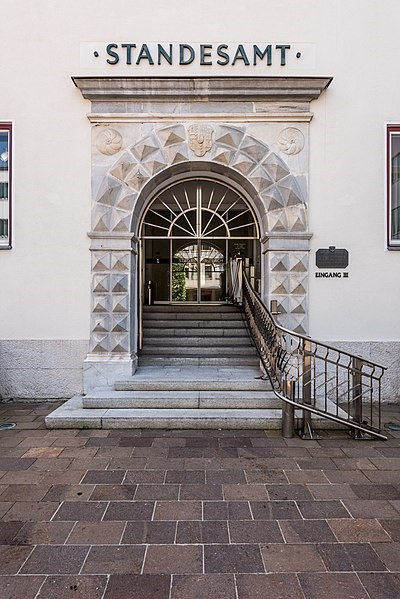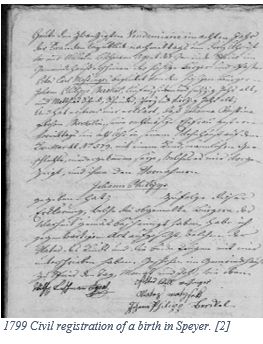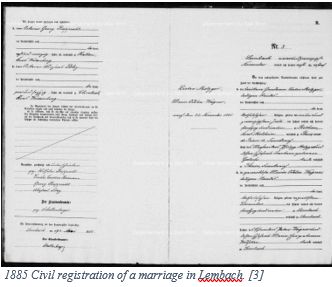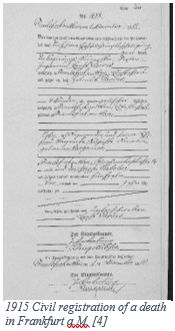German Civil Registration
 14
14Aug

While church records are a key record type to use in German genealogy research, civil registrations are also important, especially after 1876, when civil registration became mandatory in all German states. Some advantages of using civil registrations include: 1) the birth date is recorded (church records sometimes only record the baptism date), 2) one does not need to know the ancestor’s religion, just the town in which the event took place, and 3) they provide more details than church records. German terms for civil registers include Standesamtsregister, Zivilstandsregister, or Personenstandsregister.
German Genealogy Civil Registration
History
Individual German states started keeping civil registration at different times. French occupation influenced the establishment of civil registration in German states. Therefore, areas located on the left side of the Rhine river had earlier start dates. Below is a list of when civil registration began in various areas [1]:
1792 Alsace-Lorraine, Baden, Palatine, Rhineland
1799 Hamburg
1803 Hesse, Hessen-Nassau
1808 Westphalia
1809 Hanover
1811 Lübeck, Oldenburg
1850 Anhalt
1874 Brandenburg, Hohenzollern, Pomerania, Posen, East and West Prussia, Saxony
(Province), Schleswig-Holstein, Silesia
1876 Bavaria, Brunswick, Lippe, Mecklenburg, Saxony (Kingdom), Thuringia, Württemberg
It is important to keep in mind that once the French troops left not all areas continued keeping civil registration.
How to access records
Not every town had a civil registration office. Gazetteers can be used to determine where civil registration records were kept for a given town.
Some civil registration records have been digitized and are available online. Civil registers for the Alsace-Lorraine region can be viewed online at the Bas-Rhin Departmental Archive website (www.archives.bas-rhin.fr). Search for “Germany civil registration” in the Ancestry.com card catalog to view available collections. When searching by place name in FamilySearch, look for civil registration in the list of available record types for the place. More and more records are being digitized, but there may still be some that can only be viewed on microfilm.
Many civil registration records can only be accessed in Germany. While many may be digitized, they are not available online, so an on-site research at local city or state archives may be required. In some cases, such as in smaller communities, the civil registrar may be willing to conduct some research for you for a fee. If the records you are looking for are not available online, the website Standesamt.com is a helpful tool for looking up contact information for the civil registration office of interest. If you have names and dates, you can also order certificates online.
Record format of information typically included
Civil registration records are written in paragraph form. Some may be completely hand-written, while others use a pre-printed form that is filled in. Depending on the area and time-period, the French influence will be apparent. Some records were written in French instead of German. Or, as in the example below, the record written in German used the French Republican calendar.
 “Heute den zwanzigsten Vendemiaire im achten Jahr der Francken Republick…” Today, the twentieth vendémiaire in the eighth year of the French Republic…
“Heute den zwanzigsten Vendemiaire im achten Jahr der Francken Republick…” Today, the twentieth vendémiaire in the eighth year of the French Republic…
The following records will typically include the listed information. However, information provided can vary through time and by region or town.
Birth records:
- birth date and time,
- child’s name and gender,
- parents’ names (including mother’s maiden name),
- father’s occupation,
- parents’ ages,
- parents’ residence, and
- parents’ religion.
Marriage records (usually two pages):
 For both the bride and groom:
For both the bride and groom:
- name,
- birth date (or ages) and birth place,
- residence,
- occupation or status,
- marital status,
- religion,
- marriage date and place.
For each set of parents:
- names (including mothers’ maiden names),
- fathers’ occupations,
- ages,
- residence,
- whether parents are still living.
 Death records:
Death records:
- name,
- maiden name,
- occupation or status,
- birth date (or age) and birth place,
- religion,
- last residence,
- marital status,
- spouse’s name (including maiden name, if married),
- parents’ names,
- death date and place.
Copies were often made of registers. The original register may be termed “Hauptregister” and the copy “Nebenregister.” Both are equally valuable, though there is always a chance of transcription error when making a copy.
Our researchers at Price Genealogy are experienced in helping people with their German genealogy. Let us know how we can help you.
Gina
[1] FamilySearch Wiki (www.familysearch.org), “German Civil Registration Time Periods,” rev. 13:25, 6 January 2016.
[2] Zivilstandsregister, Standesamt Speyer (Bayern), Geburten 1798-1805, FamilySearch (http://www.familysearch.org : accessed 4 August 2020), digital image 99, p. 3; DGS 8,232,760, FHL Film 192,357.
[3] "Departmental Archives of Bas-Rhin, accessed 4 August 2020, http://archives.bas-rhin.fr/detail-document/ETAT-CIVIL-C262-P1-R166024#visio/page:ETAT-CIVIL-C262-P1-R166024-2823244.”
[4] “Deutschland, Hessen, Standesbücher 1874-1927,” FamilySearch (http://www.familysearch.org : accessed 4 August 2020), Frankfurt am Main, Sterbenebenregister 1915, image 56. Image courtesy of Hessian State Archives Marburg.
Do you have any German genealogy that you're currently working on? Let us know in a comment below!
